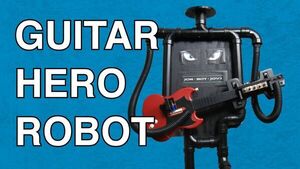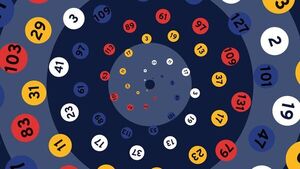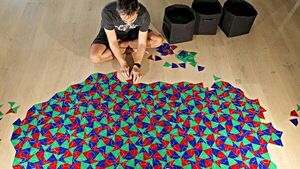2021-05-13 - Nº 315
Editorial
Esta é a Newsletter Nº 315 que se apresenta com o mesmo formato que as anteriores. Se gostar da Newsletter partilhe-a!
Todas as Newsletters encontram-se indexadas no link.
Esta Newsletter tem os seguintes tópicos:
Faz hoje anos que nascia, em 1713, o matemático, astrónomo e geofísico francês Alexis Clairaut. Ele foi um newtoniano proeminente cujo trabalho ajudou a estabelecer a validade dos princípios e resultados que Sir Isaac Newton delineou nos Principia de 1687. Clairaut foi uma das figuras-chave na expedição à Lapónia que ajudou a confirmar a teoria de Newton para a figura da Terra. Nesse contexto, Clairaut elaborou um resultado matemático agora conhecido como "teorema de Clairaut". Ele também abordou o problema gravitacional dos três corpos, sendo o primeiro a obter um resultado satisfatório para a precessão absidal da órbita lunar. Em matemática, ele também é creditado com a equação de Clairaut e a relação de Clairaut.
Faz também hoje anos que nascia, em 1857, o médico, bacteriologista e matemático inglês Ronald Ross. Ele localizou o parasita da malária no intestino do mosquito Anopheles, identificando-o como o vector da doença. Por esta descoberta ele tornou-se o primeiro prémio Nobel britânico, quando recebeu o Prémio Nobel da Medicina em 1902. O seu estudo da malária começou em 1892. Em 1894, ele conduziu experiências na Índia para determinar a validade da hipótese de Alphonse Laveran e Patrick Manson de que os mosquitos espalham a doença. Demorou dois anos e meio de esforço antes que Ross conseguisse elucidar o ciclo de vida dos parasitas da malária nos mosquitos. Num trabalho posterior, na África Ocidental, ele também determinou a espécie de mosquito que carrega a mortal febre africana.
Por fim, faz hoje anos que nascia, em 1865, o químico alemão F. K. Johannes Thiele. Ele pesquisou moléculas orgânicas não-saturadas conjugadas (envolvendo ligações simples e duplas alternadas ao longo de uma cadeia de carbono) seguidas por outros químicos, produzindo novas ideias para teorias sobre os mecanismos das reacções orgânicas. Ele estendeu a ideia (1865) de August Kekulé para a estrutura em anel do benzeno com uma hipótese de “valência parcial”, para a qual ele sugeriu uma estrutura de ressonância com ligações parciais representadas por um círculo tracejado desenhado dentro do anel de carbono (1899). Ele também estudou a química dos compostos de nitrogénio e descobriu muitos novos compostos e métodos de síntese. Ele investigou guanidina, hidrazina e seus derivados (alguns dos quais explosivos). Ele inventou o tubo Thiele para medir os pontos de fusão.
Nesta semana que passou os restos do foguetão Long March-5b, lançado no passado dia 5 de Maio, reentraram na atmosfera. A maior parte do foguetão foi destruída ao reentrar na atmosfera, mas o resto dos destroços caiu a oeste das Maldivas no oceano Indico, no passado domingo.
Também nesta semana que passou o helicóptero marciano Ingenuity fez o seu quinto voo. Neste, o helicóptero dirigiu-se para o sul para apoiar pesquisas futuras sobre o uso potencial deste tipo de meio aéreo em Marte no futuro. O Ingenuity Mars Helicopter da NASA completou seu quinto voo no Planeta Vermelho com sua primeira viagem de ida do Wright Brothers Field para um campo de aviação a sul em 129 metros. Após a chegada acima de seu novo local, o Ingenuity alcançou um recorde de altitude de 10 metros e capturou imagens coloridas de alta resolução da sua nova vizinhança antes de pousar.
Na Newsletter desta semana apresentamos diversas noticias, artigos científicos, projetos de maker assim como alguns videos interessantes. É apresentado a revista newelectronics de 11 de Maio.
 João Alves ([email protected])
João Alves ([email protected])
O conteúdo da Newsletter encontra-se sob a licença  Creative Commons Attribution-NonCommercial-ShareAlike 4.0 International License.
Creative Commons Attribution-NonCommercial-ShareAlike 4.0 International License.
Novidades da Semana
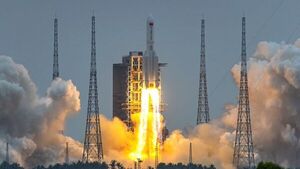
Chinese rocket debris crashes into Indian Ocean - state media
"The remains of a Chinese rocket that was hurtling back towards Earth have crashed into the Indian Ocean, the country's space agency says. The bulk of the rocket was destroyed as it re-entered the atmosphere, but state media reported that debris landed just west of the Maldives on Sunday. There have been days of speculation over where the rocket might land, and US officials and other experts warned its return risked potential casualties. But China insisted the risk was low. The Long March-5b vehicle re-entered the atmosphere at 10:24 Beijing time (02:24 GMT) on Sunday, state media reported, citing the Chinese Manned Space Engineering office. There were no reports of injuries or damage." [...]

NASA’s Ingenuity Mars Helicopter Completes First One-Way Trip
"The Red Planet rotorcraft headed south in support of furthering research into the potential use of aerial scouts on Mars in the future. NASA’s Ingenuity Mars Helicopter completed its fifth flight on the Red Planet today with its first one-way journey from Wright Brothers Field to an airfield 423 feet (129 meters) to the south. After arrival above its new airfield, Ingenuity climbed to an altitude record of 33 feet (10 meters) and captured high-resolution color images of its new neighborhood before touching down. The flight represents the rotorcraft’s transition to its new operations demonstration phase. This phase will focus on investigating what kind of capabilities a rotorcraft operating from Mars can provide. Examples include scouting, aerial observations of areas not accessible by a rover, and detailed stereo imaging from atmospheric altitudes." [...]
Outras Notícias

Intel Launches New 11th Gen Core for Mobile
"The new 11th Generation Intel® Core™ H-series mobile processors (code-named “Tiger Lake-H”) launched worldwide today, led by the flagship Intel® Core™ i9-11980HK — the “World’s Best Gaming Laptop Processor.”1 The Intel Core i9-11980HK delivers the highest-performance2 in laptops for gaming, content creators and business professionals reaching speeds of up to 5.0 gigahertz (GHz). About Desktop-Caliber Gaming Performance on Mobile: With new 11th Gen Intel Core H-series processors, Intel leverages deep expertise in advanced processor design and PC gaming to bring the world’s best gaming laptop processors1 to gamers around the globe. Extending the performance momentum established by the 11th Gen Intel Core H35 series, the 11th Gen Intel H-series processors, based on 10 nanometer SuperFin process technology, feature up to 8 cores and 16 threads, with single and dual-core turbo performance up to 5.0GHz. Additionally, the central processing unit (CPU) can directly access high-speed GDDR6 memory attached to the graphics card, enabling gamers to experience higher framerates with lower latency, and load large textures faster. The mobile processor offers 2.5 times the total PCIe bandwidth to the CPU compared with the 10th Gen H-series processors, and three times the total PCIe bandwidth compared with other industry processors. About This Bleeding-Edge Platform: 11th Gen Intel Core H-series mobile processors empower creators and business professionals to execute tasks faster, from anywhere, thanks to best-in-class components and connectivity 3." [...]
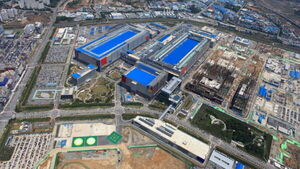
Samsung Electronics to Boost Investment in Logic Chip Businesses to KRW 171 Trillion by 2030
"To increase investment by KRW 38 trillion to further advance research, build new fab New production line in Pyeongtaek to be completed in 2H 2022, producing 14nm DRAM and 5nm logic chips Samsung Electronics, a world leader in advanced semiconductor technology, today announced that it will increase its investments in the System LSI and Foundry businesses through 2030 to a total of KRW 171 trillion, to accelerate research of cutting-edge semiconductor process technology and construction of a new production facility. The plan represents an increase of KRW 38 trillion from the previous commitment of KRW 133 trillion announced in April 2019 and is expected to help the Company reach its goal of becoming the world leader in logic chips by 2030. For the past two years, Samsung has been closely collaborating with various semiconductor design companies, component and equipment manufacturers, as well as academia in making progress towards that goal. The expansion of the Company’s Foundry Business will help fuel entire new industries built on next-generation technologies like AI, 5G and autonomous driving. The Company also announced that it has begun construction of a new production line in Pyeongtaek, Korea, which is expected to be completed in the second half of 2022. The state-of-the-art facility equipped with the latest technology, P3, will produce 14-nanometer DRAM and 5-nanometer logic semiconductors, both based on extreme ultraviolet (EUV) lithography technology." [...]
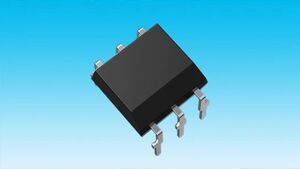
Toshiba’s 1-Form-B Photorelay Expands Applications with Industry’s Highest ON-State Current Rating
"Toshiba Electronic Devices & Storage Corporation ("Toshiba") has launched “TLP4590A,” a 1-Form-B (normally closed) photorelay in a DIP6 package featuring an industry-leading[1] 1.2A increased ON-state current rating and a 60V OFF-state output terminal voltage rating. Volume shipments start today. The ON-state current rating of 1.2A is the highest in the industry, 140% higher than Toshiba's current product, TLP4176A. The maximum operating temperature rating of 110ºC facilitates easy achievement of designs with the temperature margins required for application in heating, ventilation, and air conditioning (HVAC), security systems, and building automation system equipment, where many 1-Form-B relays are used. TLP4590A also features an isolation voltage (min.) of 5,000Vrms, allowing it to be used in equipment that requires high insulation performance." [...]

Portenta Machine Control: Add a powerful brain to your machines
"Arduino Pro is introducing a powerful new member of the Portenta product family, the Portenta Machine Control. It’s a fully-centralized, low-power, industrial control unit able to drive equipment and machinery. Plus, you can program it using the Arduino framework or other embedded development platforms. Thanks to its computing power, the Portenta Machine Control enables a wide range of predictive maintenance and AI use cases. It enables the collection of real-time data from the factory floor, while supporting remote control of equipment, including from the cloud. Key benefits include: - Shorter time-to-market - Enhance existing products - Add connectivity for monitoring, as well as control - Each I/O pin can be configured, so you can tailor it to your needs - Make equipment smarter, as well as AI-ready - Provide security and robustness from the ground up - Open new business model opportunities (such as servitization) - Interact with your equipment with advanced human-machine interfaces (HMI) - Modular design for adaptation, expansion and upgrades Business as a Service The Portenta Machine Control allows companies to enable new business-as-a-service models." [...]

Germany to Support Quantum Computing With 2 Billion Euros
"Germany will spend about 2 billion euros ($2.4 billion) to support the development of its first quantum computer and related technologies in the next four years, the economy and science ministries said on Tuesday. The science ministry will spend 1.1 billion euros by 2025 to support research and development in quantum computing, which uses the phenomena of quantum mechanics to deliver a leap forward in computation. The economy ministry will spend 878 million euros backing practical applications. Germany's Aerospace Center (DLR) will receive the bulk of the subsidies - about 740 million euros - to team up with industrial companies, medium-sized enterprises and start-ups to forge two consortia, the economy ministry said. "Quantum computing has the potential to revolutionize key industries of our economy," Economy Minister Peter Altmaier said. Altmaier pointed to applications in areas such as better management of supply and demand in the energy sector, improved traffic control and faster testing of new active substances." [...]

As NASA’s Voyager 1 Surveys Interstellar Space, Its Density Measurements Are Making Waves
"In the sparse collection of atoms that fills interstellar space, Voyager 1 has measured a long-lasting series of waves where it previously only detected sporadic bursts. Until recently, every spacecraft in history had made all of its measurements inside our heliosphere, the magnetic bubble inflated by our Sun. But on Aug. 25, 2012, NASA’s Voyager 1 changed that. As it crossed the heliosphere’s boundary, it became the first human-made object to enter – and measure – interstellar space. Now eight years into its interstellar journey, a close listen of Voyager 1’s data is yielding new insights into what that frontier is like. If our heliosphere is a ship sailing interstellar waters, Voyager 1 is a life raft just dropped from the deck, determined to survey the currents." [...]

Perseverance’s Robotic Arm Starts Conducting Science
"NASA’s newest Mars rover is beginning to study the floor of an ancient crater that once held a lake. NASA’s Perseverance rover has been busy serving as a communications base station for the Ingenuity Mars Helicopter and documenting the rotorcraft’s historic flights. But the rover has also been busy focusing its science instruments on rocks that lay on the floor of Jezero Crater. What insights they turn up will help scientists create a timeline of when an ancient lake formed there, when it dried, and when sediment began piling up in the delta that formed in the crater long ago. Understanding this timeline should help date rock samples – to be collected later in the mission – that might preserve a record of ancient microbes. A camera called WATSON on the end of the rover’s robotic arm has taken detailed shots of the rocks." [...]

NASA’s Parker Solar Probe Discovers Natural Radio Emission in Venus’ Atmosphere
"During a brief swing by Venus, NASA’s Parker Solar Probe detected a natural radio signal that revealed the spacecraft had flown through the planet’s upper atmosphere. This was the first direct measurement of the Venusian atmosphere in nearly 30 years — and it looks quite different from Venus past. A study published today confirms that Venus’ upper atmosphere undergoes puzzling changes over a solar cycle, the Sun’s 11-year activity cycle. This marks the latest clue to untangling how and why Venus and Earth are so different. Born of similar processes, Earth and Venus are twins: both rocky, and of similar size and structure. But their paths diverged from birth." [...]
Ciência e Tecnologia
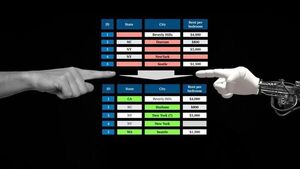
New system cleans messy data tables automatically
"With just 50 lines of code, the program spots and fixes likely errors. MIT researchers have created a new system that automatically cleans “dirty data” — the typos, duplicates, missing values, misspellings, and inconsistencies dreaded by data analysts, data engineers, and data scientists. The system, called PClean, is the latest in a series of domain-specific probabilistic programming languages written by researchers at the Probabilistic Computing Project that aim to simplify and automate the development of AI applications (others include one for 3D perception via inverse graphics and another for modeling time series and databases). According to surveys conducted by Anaconda and Figure Eight, data cleaning can take a quarter of a data scientist's time. Automating the task is challenging because different datasets require different types of cleaning, and common-sense judgment calls about objects in the world are often needed (e.g., which of several cities called “Beverly Hills” someone lives in). PClean provides generic common-sense models for these kinds of judgment calls that can be customized to specific databases and types of errors." [...]
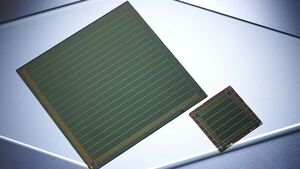
Perovskite Solar Modules: High Efficiency on a Large Surface Area
"Researchers at KIT combine laser-based series interconnection with vacuum processing of all solar cell layers – upscaling paves the way from lab to industry From cell to module without loss of efficiency: This is one of the main challenges of perovskite photovoltaics. Researchers at Karlsruhe Institute of Technology (KIT) have now managed to produce perovskite solar modules with minimum scaling loss. For this purpose, they combined laser-based series interconnections with vacuum processing of all layers of the solar cell. They achieved an 18 percent efficiency on an area of four square centimeters – a world record for vacuum-processed perovskite solar modules. In photovoltaics, perovskite semiconductors are regarded as particularly promising materials thanks to their low-cost availability, ease of manufacture and enormous potential with regard to efficiency. Perovskite solar cells have evolved in a unique way over the past decade." [...]
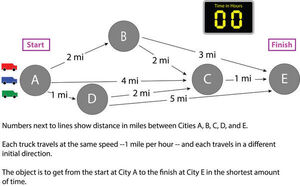
Race Logic: Novel Circuitry Solves a Myriad of Computationally Intensive Problems With a Minimum of Energy
"From the branching pattern of leaf veins to the variety of interconnected pathways that spread the coronavirus, nature thrives on networks — grids that link the different components of complex systems. Networks underlie such real-life problems as determining the most efficient route for a trucking company to deliver life-saving drugs and calculating the smallest number of mutations required to transform one string of DNA into another. Instead of relying on software to tackle these computationally intensive puzzles, researchers at the National Institute of Standards and Technology (NIST) took an unconventional approach. They created a design for an electronic hardware system that directly replicates the architecture of many types of networks. The researchers demonstrated that their proposed hardware system, using a computational technique known as race logic, can solve a variety of complex puzzles both rapidly and with a minimum expenditure of energy. Race logic requires less power and solves network problems more rapidly than competing general- purposed computers." [...]

Pepsin-Degradable Plastics of BioNylons from Itaconic and Amino Acids
"Marine plastic waste problems have been more serious year by year. One of the worst issues is that creatures in ocean are going extinct by mistakenly swallowing them. Conventional biodegradable plastics are degradable in digestive enzymes, but their performances are too low to use in society. In this study, researchers from JAIST have used bio-derived resources such as itaconic acid and amino acid for the syntheses of high-performance BioNylons having the pepsin degradation function. Currently available conventional nylon such as Nylon 6, Nylon 66, and Nylon 11 are nondegradable. On the other hand, BioNylons derived from itaconic acid showed higher performances than conventional ones and degradability in soil, but degradability under the digestive enzymes was not confirmed." [...]
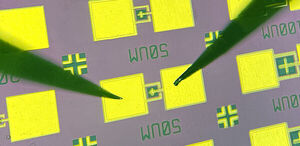
Making the shift from blue to red for better LEDs
"Pure red-light micrometer-scale emitting devices made from a nitride semiconductor reaches excellent efficiency. A new micro-light-emitting diode (micro-LED) developed at KAUST can efficiently emit pure red light and may help in the quest to develop full-color displays based on just a single semiconductor. Micro-LEDs are a promising technology for the next generation of displays. They have the advantage of being energy efficient and very small. But each LED can only emit light over a narrow range of colors. A clever solution is to create devices that combine many different LEDs, each emitting a different color." [...]
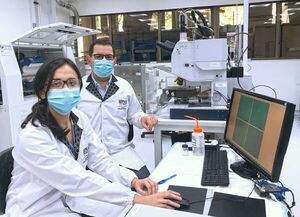
NUS scientists create a new type of intelligent material
"Known as “two-dimensional electrolytes”, these smart materials could potentially be used in many things from drug delivery to energy storage Intelligent materials, the latest revolution in the field of materials science, can adapt their properties depending on changes in their surroundings. They can be used in everything from self-healing mobile phone screens, to shape-shifting aeroplane wings, and targeted drug delivery. Delivering drugs to a specific target inside the body using intelligent materials is particularly important for diseases like cancer, as the smart material only releases the drug payload when it detects the presence of a cancer cell, leaving the healthy cells unharmed. Now, researchers from the Centre for Advanced 2D Materials (CA2DM) at the National University of Singapore (NUS) have created a new class of intelligent materials. It has the structure of a two-dimensional (2D) material, but behaves like an electrolyte – and could be a new way to deliver drugs within the body. Just like traditional electrolytes, these new “2D-electrolytes” dissociate their atoms in different solvents, and become electrically charged." [...]

Priceless Astronomy Data Saved After Collapse of Arecibo Telescope
"When Puerto Rico’s famed Arecibo telescope collapsed in 2020, astronomers lost access to one of the world’s most treasured pieces of equipment – but also, potentially, decades of priceless data holding still undiscovered secrets about the universe. Now, thanks to a data rescue plan led by the Texas Advanced Computing Center at The University of Texas at Austin, Arecibo’s observations will be preserved for generations of future astronomers. Millions of people have seen footage of the collapse in December 2020 of the famed Arecibo radio telescope. The 900-ton spidery-looking instrument platform snapped its gossamer-like suspension cables, which sent it crashing through the radio dish below and into the Puerto Rican countryside, destroying the giant telescope. Astronomers worldwide keenly felt the loss of one of the world’s premier telescopes whose past achievements include discovery of the first planet found outside of our solar system and the first-ever binary pulsar, a find that tested Albert Einstein’s general theory of relativity and earned its discoverers a Nobel Prize in 1993. Luckily, the data center for the Arecibo telescope was spared any long-term damage from the collapse." [...]
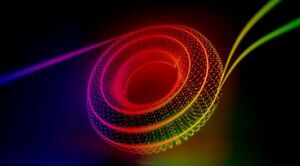
JQI Researchers Generate Tunable Twin Particles of Light
"Identical twins might seem “indistinguishable,” but in the quantum world the word takes on a new level of meaning. While identical twins share many traits, the universe treats two indistinguishable quantum particles as intrinsically interchangeable. This opens the door for indistinguishable particles to interact in unique ways—such as in quantum interference—that are needed for quantum computers. While generating a crowd of photons—particles of light—is as easy as flipping a light switch, it’s trickier to make a pair of indistinguishable photons. And it takes yet more work to endow that pair with a quantum mechanical link known as entanglement. In a paper published May 10, 2021 in the journal Nature Photonics(link is external), JQI researchers and their colleagues describe a new way to make entangled twin particles of light and to tune their properties using a method conveniently housed on a chip, a potential boon for quantum technologies that require a reliable source of well-tailored photon pairs." [...]
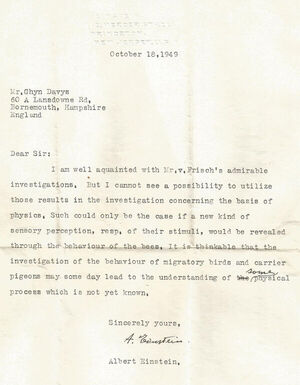
Long-lost letter from Albert Einstein discusses a link between physics and biology, seven decades before evidence emerges
"A recently discovered letter written by Albert Einstein discusses a link between physics and biology, seven decades before evidence emerges. Since the dawn of the electronic age, it has never been easier for researchers to engage with the general public — gaining access to precious resources otherwise unavailable. This is illustrated perfectly in our latest publication, in which we introduce a previously unknown letter written in 1949 by none other than Albert Einstein. In it, the German-born mathematician and physicist discusses bees, birds and whether new physics principles could come from studying animal senses. We first came across it in 2019, after Judith Davys — a retiree living in the United Kingdom — read an article we’d published on the mathematical abilities of bees. She reached out to us to share the 72-year-old letter, which Einstein had addressed to her late husband Glyn Davys." [...]

Quantum machine learning hits a limit
"A black hole permanently scrambles information that can’t be recovered with any quantum machine learning algorithm, shedding new light on the classic Hayden-Preskill thought experiment A new theorem from the field of quantum machine learning has poked a major hole in the accepted understanding about information scrambling. “Our theorem implies that we are not going to be able to use quantum machine learning to learn typical random or chaotic processes, such as black holes. In this sense, it places a fundamental limit on the learnability of unknown processes,” said Zoe Holmes, a post-doc at Los Alamos National Laboratory and coauthor of the paper describing the work published today in Physical Review Letters. “Thankfully, because most physically interesting processes are sufficiently simple or structured so that they do not resemble a random process, the results don’t condemn quantum machine learning, but rather highlight the importance of understanding its limits,” Holmes said. In the classic Hayden-Preskill thought experiment, a fictitious Alice tosses information such as a book into a black hole that scrambles the text. Her companion, Bob, can still retrieve it using entanglement, a unique feature of quantum physics." [...]

Quantum mechanics paves the way for more stable organic solar cells
"Quantum mechanics can be used to create more stable and more easily produced organic solar cells. These are the findings of new research from the University of Gothenburg. Organic solar cells have many advantages compared with traditional silicon-based solar cells. They can be manufactured cheaply at a large scale using printing presses, and they are light, malleable and flexible. The problem is that today’s organic solar cells are not as stable and effective as silicon-based solar cells. In a new study, a research group has taken on this problem and found a way that can lead to more cost-effective solar cell technology." [...]

Supernovae Twins Open Up New Possibilities for Precision Cosmology
"Findings will enhance dark energy experiments at major telescopes Cosmologists have found a way to double the accuracy of measuring distances to supernova explosions – one of their tried-and-true tools for studying the mysterious dark energy that is making the universe expand faster and faster. The results from the Nearby Supernova Factory (SNfactory) collaboration, led by Greg Aldering of the Department of Energy’s Lawrence Berkeley National Laboratory (Berkeley Lab), will enable scientists to study dark energy with greatly improved precision and accuracy, and provide a powerful crosscheck of the technique across vast distances and time. The findings will also be central to major upcoming cosmology experiments that will use new ground and space telescopes to test alternative explanations of dark energy. Two papers published in The Astrophysical Journal report these findings, with Kyle Boone as lead author. Currently a postdoctoral fellow at the University of Washington, Boone is a former graduate student of Nobel laureate Saul Perlmutter, the Berkeley Lab senior scientist and UC Berkeley professor who led one of the teams that originally discovered dark energy. Perlmutter was also a co-author on both studies." [...]

NUS researchers create AiFoam for robots to interact intelligently with their surroundings
"New creation could give machines human-like sense of touch to better judge human intentions and respond to changes in the environment Robots and machines are getting smarter with the advancement of artificial intelligence, but they still lack the ability to touch and feel their subtle and complex surroundings like human beings. Now, researchers from the National University of Singapore (NUS) have invented a smart foam that can give machines more than a human touch. Called artificially innervated foam, or AiFoam, the new material – which is soft and feels like a sponge – mimics the human sense of touch, can sense nearby objects without actually touching, and repairs itself when damaged. Compared with other conventional materials, AiFoam is the first smart foam in the world that performs these functions simultaneously, potentially making robots more intelligent and interactive. This breakthrough material was developed over two years by a team led by Assistant Professor Benjamin Tee from the NUS Department of Materials Science and Engineering, and Institute for Health Innovation & Technology (iHealthtech). “We want to show that it is possible to replicate the human sense of touch in a robot, which opens up a new paradigm in the interaction between man and machine for future applications,” said Asst Prof Tee." [...]
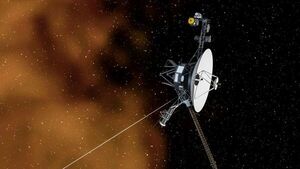
In the emptiness of space, Voyager 1 detects plasma ‘hum’
"Voyager 1 – one of two sibling NASA spacecraft launched 44 years ago and now the most distant human-made object in space – still works and zooms toward infinity. As the craft toils, it has long since zipped past the edge of the solar system through the heliopause – the solar system’s border with interstellar space – into the interstellar medium. Now, its instruments have detected the constant drone of interstellar gas (plasma waves), according to Cornell-led research published May 10 in Nature Astronomy. Examining data slowly sent back from more than 14 billion miles away, Stella Koch Ocker, a Cornell doctoral student in astronomy, has uncovered the emission. “It’s very faint and monotone, because it is in a narrow frequency bandwidth,” Ocker said. “We’re detecting the faint, persistent hum of interstellar gas.” This work allows scientists to understand how the interstellar medium interacts with the solar wind, Ocker said, and how the protective bubble of the solar system’s heliosphere is shaped and modified by the interstellar environment." [...]

A robot that can help you untangle your hair
"Robotic arm equipped with a hairbrush helps with brushing tasks and could be an asset in assistive-care settings. With rapidly growing demands on health care systems, nurses typically spend 18 to 40 percent of their time performing direct patient care tasks, oftentimes for many patients and with little time to spare. Personal care robots that brush hair could provide substantial help and relief. This may seem like a truly radical form of “self-care,” but crafty robots for things like shaving, hair-washing, and makeup are not new. In 2011, the tech giant Panasonic developed a robot that could wash, massage, and even blow-dry hair, explicitly designed to help support “safe and comfortable living of the elderly and people with limited mobility, while reducing the burden of caregivers.” Hair-combing bots, however, proved to be less explored, leading scientists from MIT’s Computer Science and Artificial Intelligence Laboratory (CSAIL) and the Soft Math Lab at Harvard University to develop a robotic arm setup with a sensorized soft brush. The robot is equipped with a camera that helps it “see” and assess curliness, so it can plan a delicate and time-efficient brush-out." [...]
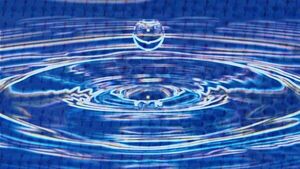
New evidence for electron’s dual nature found in a quantum spin liquid
"A new discovery led by Princeton University researchers could upend our understanding of how electrons behave under extreme conditions due to the laws of quantum physics. The finding provides experimental evidence that this familiar building block of matter often behaves as if it is made of two particles — one particle that gives the electron its negative charge and another that gives it a magnet-like property known as spin. “We think this is the first hard evidence of spin-charge separation,” said Nai Phuan Ong, Eugene Higgins Professor of Physics, the senior author on a study published this week in the journal Nature Physics. The experimental results fulfill a prediction made decades ago to explain one of the most mind-bending states of matter, the quantum spin liquid. In all materials, the spin of an electron can point either up or down. In the familiar magnet, the spins uniformly point in one direction throughout the sample when the temperature drops below a critical temperature." [...]
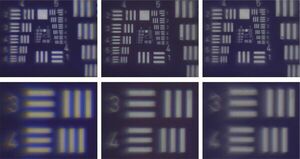
Researchers 3D Print Complex Micro-Optics with Improved Imaging Performance
"Tiny lenses could correct color distortions for digital cameras and medical endoscopes In a new study, researchers have shown that 3D printing can be used to make highly precise and complex miniature lenses with sizes of just a few microns. The microlenses can be used to correct color distortion during imaging, enabling small and lightweight cameras that can be designed for a variety of applications. “The ability to 3D print complex micro-optics means that they can be fabricated directly onto many different surfaces such as the CCD or CMOS chips used in digital cameras,” said Michael Schmid, a member of the research team from University of Stuttgart in Germany. “The micro-optics can also be printed on the end of optical fibers to create very small medical endoscopes with excellent imaging quality.” In The Optical Society (OSA) journal Optics Letters, researchers led by Harald Giessen detail how they used a type of 3D printing known as two-photon lithography to create lenses that combine refractive and diffractive surfaces. They also show that combining different materials can improve the optical performance of these lenses. “3D printing of micro-optics has improved drastically over the past few years and offers a design freedom not available from other methods,” said Schmid." [...]
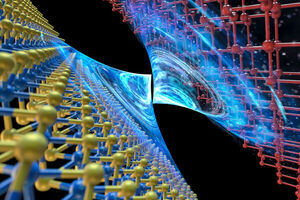
Advance may enable “2D” transistors for tinier microchip components
"Atomically thin materials are a promising alternative to silicon-based transistors; now researchers can connect them more efficiently to other chip elements. Moore’s Law, the famous prediction that the number of transistors that can be packed onto a microchip will double every couple of years, has been bumping into basic physical limits. These limits could bring decades of progress to a halt, unless new approaches are found. One new direction being explored is the use of atomically thin materials instead of silicon as the basis for new transistors, but connecting those “2D” materials to other conventional electronic components has proved difficult. Now researchers at MIT, the University of California at Berkeley, the Taiwan Semiconductor Manufacturing Company, and elsewhere have found a new way of making those electrical connections, which could help to unleash the potential of 2D materials and further the miniaturization of components — possibly enough to extend Moore’s Law, at least for the near future, the researchers say. The findings are described this week in the journal Nature, in a paper by recent MIT graduates Pin-Chun Shen PhD ’20 and Cong Su PhD ’20, postdoc Yuxuan Lin PhD ’19, MIT professors Jing Kong, Tomas Palacios, and Ju Li, and 17 others at MIT, UC Berkeley, and other institutions." [...]

Parallel universes cross in Flatland
"Physicists at the University of Bath observe modified energy landscapes at the intersection of 2D materials. In 1884, Edwin Abbott wrote the novel Flatland: A Romance in Many Dimensions as a satire of Victorian hierarchy. He imagined a world that existed only in two dimensions, where the beings are 2D geometric figures. The physics of such a world is somewhat akin to that of modern 2D materials, such as graphene and transition metal dichalcogenides, which include tungsten disulfide (WS2), tungsten diselenide (WSe2), molybdenum disulfide (MoS2) and molybdenum diselenide (MoSe2). Modern 2D materials consist of single-atom layers, where electrons can move in two dimensions but their motion in the third dimension is restricted. Due to this ‘squeeze’, 2D materials have enhanced optical and electronic properties that show great promise as next-generation, ultrathin devices in the fields of energy, communications, imaging and quantum computing, among others." [...]
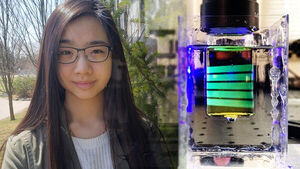
Making her mark in 3D
"Engineering co-op student helps federal experts solve a messy high-tech printing problem Tomographic 3D printing is a revolutionary technology that uses light to create three-dimensional objects. A projector beams light at a rotating vial containing photocurable resin, and within seconds the desired shape forms inside the vial. The light projections needed to solidify specific 3D regions of the polymer are calculated using tomographic imaging concepts. The technology was first demonstrated by researchers at the University of California, Berkeley and Lawrence Livermore National Labs in 2019, and a Swiss group at École Polytechnique Fédérale de Lausanne (EPFL) in 2020. It is significantly faster than traditional 3D printing in layers, can print around existing objects, and does not require support structures. Though incredible, the technology can get messy in the lab." [...]
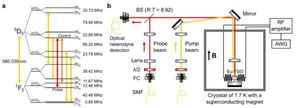
USTC Realizes Coherent Storage of Light over 1 Hour
"Remote quantum distribution on the ground is limited because of the loss of photon in optical fibers. One solution for remote quantum communication lies in quantum memories: photons are stored in the long-lived quantum memory (quantum flash drive) and then quantum information is transmitted by the transportation of the quantum memory. Given the speed of aircrafts and high-speed trains, it is critical to increase the storage time of the quantum memories to the order of hours. A research team led by Prof. LI Chuanfeng and Prof. ZHOU Zongquan from University of Science and Technology of China (USTC) of the Chinese Academy of Sciences (CAS) extended the storage time of the optical memories to over one hour. They broke the record of one minute achieved by German researchers in 2013 and made a great stride towards the application of quantum memories. The work was published in Nature Communications on April 22nd." [...]
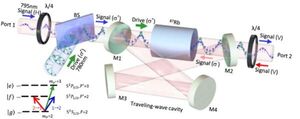
Researchers Achieve 50dB Noiseless at all Optical Isolation
"Chinese researchers achieved 51.5dB nonreciprocal isolation in the atomic ensemble, which is the highest isolation ratio in the non-magnetic nonreciprocal field. They discussed the quantum noise problem in nonreciprocal devices for the first time. The result was published on Nature Communicationson April 22, 2021. Nonreciprocity is an important basic concept in the optical field. The isolators and circulators derived from it are all indispensable components in the optical path. Faraday isolator based on circular birefringence of magneto-optical effect is widely used because of its easy construction, high isolation and low loss." [...]

New light emitters developed for quantum circuits
"The promise of a quantum internet depends on the complexities of harnessing light to transmit quantum information over fiber optic networks. A potential step forward was reported today by researchers at KTH who developed integrated chips that can generate light particles on demand and without the need for extreme refrigeration. Quantum computing today relies on states of matter, that is, electrons which carry qubits of information to perform multiple calculations simultaneously, in a fraction of the time it takes with classical computing. KTH Professor Val Zwiller says that in order to integrate quantum computing seamlessly with fiber-optic networks—which are used by the internet today—a more promising approach would be to harness optical photons. “The photonic approach offers a natural link between communication and computation,” he says. “That’s important, since the end goal is to transmit the processed quantum information using light.” Deterministic rather than random But in order for photons to deliver qubits on-demand in quantum systems, they need to be emitted in a deterministic, rather than probabilistic, fashion." [...]
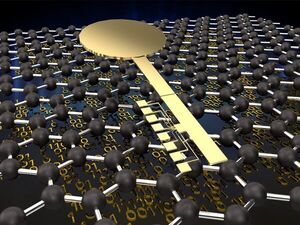
Graphene key for novel hardware security
"As more private data is stored and shared digitally, researchers are exploring new ways to protect data against attacks from bad actors. Current silicon technology exploits microscopic differences between computing components to create secure keys, but artificial intelligence (AI) techniques can be used to predict these keys and gain access to data. Now, Penn State researchers have designed a way to make the encrypted keys harder to crack. Led by Saptarshi Das, assistant professor of engineering science and mechanics, the researchers used graphene — a layer of carbon one atom thick — to develop a novel low-power, scalable, reconfigurable hardware security device with significant resilience to AI attacks. They published their findings in Nature Electronics today (May 10). “There has been more and more breaching of private data recently,” Das said." [...]
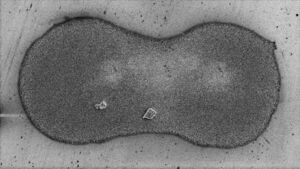
Stabiliser residue in inks inhibits conductivity in 3D printed electronics
"Very thin layers of organic stabiliser residue in metal nanoparticle (MNP) inks are behind a loss of conductivity in 3D printed materials and electronic devices, according to the findings of a new study by the University of Nottingham and the National Physical Laboratory. Inks containing metal nanoparticles are among the most commonly-used conductive materials for printed electronics. Ink-jetting layers of MNP materials allows for unpreceded design flexibility, rapid processing and 3D printing of functional electronic devices such as sensors, solar panels, LED displays, transistors and smart textiles. Inkjet 3D printing of metals typically form a solid printed object via a two-step process: solvent evaporation upon printing (pinning) and subsequent low-temperature consolidation of nanoparticles (sintering). The low temperature is important as in many applications the nanoparticles are co-printed with other functional/structural organic materials that are sensitive to higher temperatures. However, layers produced by inkjet printing of metal nanoparticles have different electrical conductivity between horizontal and vertical directions." [...]
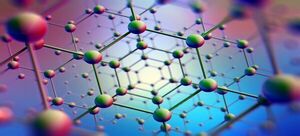
Observing Individual Atoms in 3D Nanomaterials and Their Surfaces
"Atoms are the basic building blocks for all materials. To tailor functional properties, it is essential to accurately determine their atomic structures. KAIST researchers observed the 3D atomic structure of a nanoparticle at the atom level via neural network-assisted atomic electron tomography. Using a platinum nanoparticle as a model system, a research team led by Professor Yongsoo Yang demonstrated that an atomicity-based deep learning approach can reliably identify the 3D surface atomic structure with a precision of 15 picometers (only about 1/3 of a hydrogen atom’s radius). The atomic displacement, strain, and facet analysis revealed that the surface atomic structure and strain are related to both the shape of the nanoparticle and the particle-substrate interface. Combined with quantum mechanical calculations such as density functional theory, the ability to precisely identify surface atomic structure will serve as a powerful key for understanding catalytic performance and oxidation effect." [...]
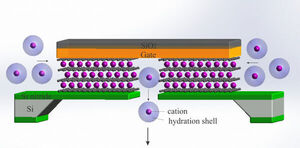
Scaling down Ionic Transistors to the ultimate limit
"The human brain is a vast network of billions of biological cells called Neurons which fires electrical signals that process information, resulting in our sense and thoughts. The ion channels of atomic scale in each neuron cell membrane plays a key role in such firings that opens and closes the ion flow in an individual cell by the electrical voltage applied across the cell membrane, acting as a “biological transistor” similar to electronic transistors in computers. For decades, scientists have learned that biological ion channels are life’s transistors capable to gate extremely fast and precisely selective permeation of ions through the atomic-scale selectivity filters to maintain vital living functions. However, it remains a grand challenge to date to produce artificial structures to mimic such biological systems for fundamental understanding and practical applications. Researchers led by Professor Xiang Zhang, the President of the University of Hong Kong (HKU), have developed an atomic-scale ion transistor based on electrically gated graphene channels of around 3 angstrom width which demonstrated highly selective ion transport. They also found that ions move a hundred times faster in such a tiny channel than they do in bulk water." [...]

3D printing lays the foundation for a new range of diagnostic tests
"Researchers at KU Leuven have developed a 3D printing technique that extends the possibilities of lateral flow testing. These tests are widespread in the form of the classic pregnancy test and the COVID-19 self-tests. With the new printing technique, advanced diagnostic tests can be produced that are quick, cheap, and easy to use. The COVID-19 pandemic has made everyone aware of the importance of rapid diagnosis. The sale of self-tests in pharmacies has been permitted in Belgium since the end of March. This self-test is a so-called lateral flow test." [...]

Smart finger ring with integrated RFID chip
"House key, wallet, health insurance card, hotel key card — a smart finger ring could replace all these in the future. Produced by a 3D printing process, the ring has an integrated RFID chip, tamper-proof, sealed and invisible. The technology of integrating electronics during 3D printing can of course be used for other applications too. The multifunctional ring was developed by a research team at Fraunhofer Institute for Casting, Composite and Processing Technology IGCV. Now, where’s my house key — could I have left it in the office? And when we want to pull out our wallet at the supermarket checkout, we often find that it’s somehow made way to the bottom of the shopping bag in all the hustle and bustle." [...]
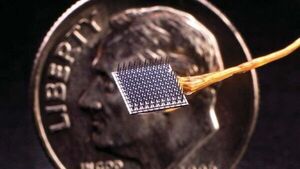
Brain Computer Interface Turns Mental Handwriting into Text on Screen
"Researchers have, for the first time, decoded the neural signals associated with writing letters, then displayed typed versions of these letters in real time. They hope their invention could one day help people with paralysis communicate. Scientists are exploring a number of ways for people with disabilities to communicate with their thoughts. The newest and fastest turns back to a vintage means for expressing oneself: handwriting. For the first time, researchers have deciphered the brain activity associated with trying to write letters by hand. Working with a participant with paralysis who has sensors implanted in his brain, the team used an algorithm to identify letters as he attempted to write them." [...]
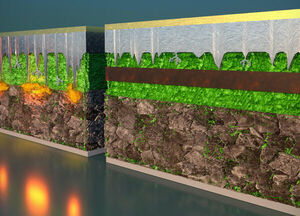
A long-lasting, stable solid-state lithium battery
"Researchers demonstrate a solution to a 40-year problem Long-lasting, quick-charging batteries are essential to the expansion of the electric vehicle market, but today’s lithium-ion batteries fall short of what’s needed — they’re too heavy, too expensive and take too long to charge. For decades, researchers have tried to harness the potential of solid-state, lithium-metal batteries, which hold substantially more energy in the same volume and charge in a fraction of the time compared to traditional lithium-ion batteries. “A lithium-metal battery is considered the holy grail for battery chemistry because of its high capacity and energy density,” said Xin Li, Associate Professor of Materials Science at the Harvard John A. Paulson School of Engineering and Applied Science (SEAS). “But the stability of these batteries has always been poor.” Now, Li and his team have designed a stable, lithium-metal solid state battery that can be charged and discharged at least 10,000 times — far more cycles than have been previously demonstrated — at a high current density. The researchers paired the new design with a commercial high energy density cathode material. This battery technology could increase the lifetime of electric vehicles to that of the gasoline cars — 10 to 15 years — without the need to replace the battery." [...]

Brand new physics of superconducting metals refuted by Lancaster physicists
"Lancaster scientists have demonstrated that other physicists’ recent “discovery” of the field effect in superconductors is nothing but hot electrons after all. A team of scientists in the Lancaster Physics Department have found new and compelling evidence that the observation of the field effect in superconducting metals by another group can be explained by a simple mechanism involving the injection of the electrons, without the need for novel physics. Dr Sergey Kafanov, who initiated this experiment, said: “Our results unambiguously refute the claim of the electrostatic field effect claimed by the other group. This gets us back on the ground and helps maintain the health of the discipline.” The experimental team also includes Ilia Golokolenov, Andrew Guthrie, Yuri Pashkin and Viktor Tsepelin. Their work is published in the latest issue of Nature Communications. When certain metals are cooled to a few degrees above absolute zero, their electrical resistance vanishes – a striking physical phenomenon known as superconductivity." [...]
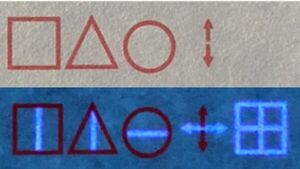
An uncrackable combination of invisible ink and artificial intelligence
"Coded messages in invisible ink sound like something only found in espionage books, but in real life, they can have important security purposes. Yet, they can be cracked if their encryption is predictable. Now, researchers reporting in ACS Applied Materials & Interfaces have printed complexly encoded data with normal ink and a carbon nanoparticle-based invisible ink, requiring both UV light and a computer that has been taught the code to reveal the correct messages. Even as electronic records advance, paper is still a common way to preserve data. Invisible ink can hide classified economic, commercial or military information from prying eyes, but many popular inks contain toxic compounds or can be seen with predictable methods, such as light, heat or chemicals. Carbon nanoparticles, which have low toxicity, can be essentially invisible under ambient lighting but can create vibrant images when exposed to ultraviolet (UV) light – a modern take on invisible ink." [...]

Evading the uncertainty principle in quantum physics
"In quantum mechanics, the Heisenberg uncertainty principle dictates that the position and speed of an object cannot both fully be known precisely at the same time. In a study published this week in Science, researchers show that two vibrating drumheads, the size of a human hair, can be prepared in a quantum state which evades the uncertainty principle for the first time. The uncertainty principle, first introduced by Werner Heisenberg in the late 1920s, is a fundamental concept of quantum mechanics. In the quantum world, particles like the electrons that power all electrical product can also behave like waves. As a result, particles cannot have a well-defined position and momentum simultaneously. For instance, measuring the momentum of a particle leads to a disturbance of position, and therefore position cannot be precisely defined." [...]
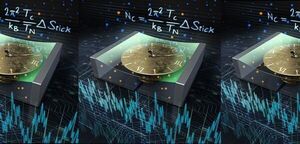
Heatstroke: why the hotter the clock, the more accurate its timekeeping
"Clocks are essential building blocks of modern technology, from computers to GPS receivers. They are also essentially engines, irreversibly consuming resources in order to generate accurate ticks. But what resources have to be expended to achieve a desired accuracy? In our latest study, published in Physical Review X, we answer this question by measuring, for the first time, the entropy generated by a minimal clock. Humans have mastered the art of timekeeping to an accuracy of approximately one second in every one hundred million years. However, the thermodynamic cost of timekeeping, i.e." [...]
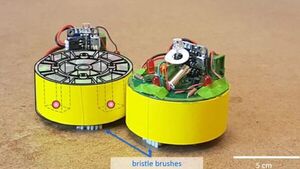
Simple Robots, Smart Algorithms: Meet the BOBbots
"Anyone with children knows that while controlling one child can be hard, controlling many at once can be nearly impossible. Getting swarms of robots to work collectively can be equally challenging, unless researchers carefully choreograph their interactions — like planes in formation — using increasingly sophisticated components and algorithms. But what can be reliably accomplished when the robots on hand are simple, inconsistent, and lack sophisticated programming for coordinated behavior? A team of researchers led by Dana Randall, ADVANCE Professor of Computing and Daniel Goldman, Dunn Family Professor of Physics, sought to show that even the simplest of robots can still accomplish tasks well beyond the capabilities of one, or even a few, of them. The goal of accomplishing these tasks with what the team dubbed "dumb robots" (essentially mobile granular particles) exceeded their expectations, and the researchers report being able to remove all sensors, communication, memory and computation — and instead accomplishing a set of tasks through leveraging the robots' physical characteristics, a trait that the team terms "task embodiment." The team's simple BOBbots, or "behaving, organizing, buzzing bots" were named for granular physics pioneer Bob Behringer," explains Randall." [...]
Documentação
A documentação é parte essencial do processo de aprendizagem e a Internet além de artigos interessantes de explorar também tem alguma documentação em formato PDF interessante de ler. Todos os links aqui apresentados são para conteúdo disponibilizado livremente pelo editor do livro.
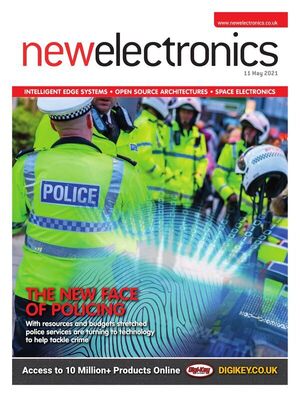
newelectronics 11 Maio 2021
"New Electronics is a fortnightly magazine focusing on technological innovation, news and the latest developments in the electronics sector. Downloadable as a digital page turner or pdf file, or offered as a hard copy, the New Electronics magazine is available in a format to suit you. " [...]
Projetos Maker
Diversos Projetos interessantes.
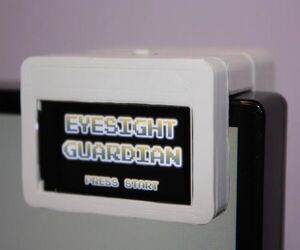
Eyesight Guardian - Protect Your Eyes With Arduino
"How often have you used a screen for hours, only to find your eyes feeling strained, tired, and sore? Especially with the pandemic we're all working and studying using our computers more than ever before, and because of this eye care is even more important than normal. To protect your eyes when using screens, you may have heard of the 20-20-20 rule. What this means, is that you should look away from your screen for 20 seconds every 20 minutes, to a distance of 20 feet or more. This helps relax your eyes, and helps ward off eye strain. Remembering to do this every 20 minutes sounds difficult, right?" [...]
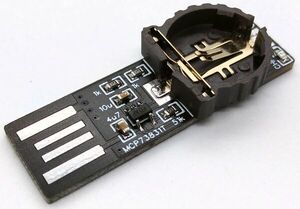
LIR1220 Charger
"Charger for LIR1220 Li-Ion batteries based on MCP73831. " [...]

Edge Impulse Object Detection on Balena OS
"Get started with Edge Impulse object detection in few minutes using one click deployment to Balena OS. Edge Impulse recently introduced official support for Raspberry Pi 4 which is the easiest way to build Machine Learning solutions on real embedded hardware. It contains tools that let you collect data from any microphone or camera, can be used with the Node.js, Python, Go and C++ SDKs to collect data and run impulses with full hardware acceleration. While Edge Impluse Linux SDK does all the magic from collecting data through running inference on your Raspberry Pi, still there are some manual steps you need to follow to get your embedded device ready to use the SDK. We have been working to "balenafy" the entire process so that you can start training your model with just a few clicks. " [...]
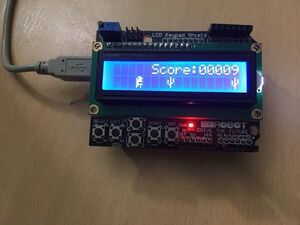
Google Chrome Dinosaur Game on 16x2 LCD Shield
"A fun, little offline game "ported" to an AVR MCU. Something that was bothering me for some time now is that I haven't made anything fun in a while, mainly because I lack good ideas for things like that. Luckily, an idea came to my mind to do this project out of nowhere, and viola, here we are. Now, just to point out, this project was NOT written in Arduino, rathte pure AVR C code using Atmel Studio. I am using an Arduino Uno and an Uno-compatible shield, but mainly because that is the cheapest and most available thing I have with me (same goes for the keypad shield I have it for years now). So for anyone familiar with C but only worked in Arduino, about half of the code would look confusing here, but take it from someone who took to learn AVR C (by myself), it's not hard at all as I managed to adapt to it in a week (more less)." [...]
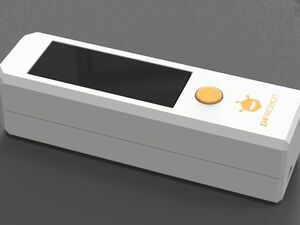
Do you want a luxurious IR laser measuring scale?
"Today, I will show you a "long-distance" and "high-precision" self-made high-standard measuring scale. High-end applications only require the best-quality ingredients and the simplest production methods. I have been busy for a few hours... Go ahead! Let’s see it. Step1: DF Selected Infrared Laser Distance Sensor (50m/80m) This is the gospel for OCD patient ------ an infrared laser distance sensor with an error within only 1mm. It is a high-performance distance sensor with high precision, long-distance use, visible infrared laser, small field of view and other characteristics." [...]
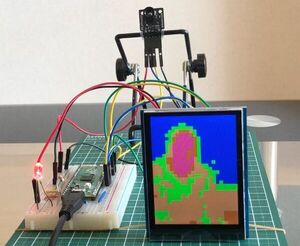
Intruder detection using ultra low powered thermal vision
"A system which detects intruders in dark with a low resolution thermal camera connected to a Raspberry Pi Pico using a TensorFlow Lite model Suppose you are alone at home or out for shopping or on vacations and someone breaks into your house. First thing comes into your mind is: if there is some gadget or home security system which can alert you or your neighbors. The home security camera does a good job but they may not work in complete dark. Also, you do not want your gadget to turn on false alarm if it is a cat. In this project I built a proof of concept which merely turn on an LED when it detects a person in light or dark using just a Raspberry Pi Pico and a thermal camera. Data collection for training The first and the most important step in a machine learning project is to collect the training data in such a way that it should cover most of the representative cases for a given task." [...]

Menus for Micropython
"Simple but powerful, multitasking menus for Micropython, using a little display board and a rotary encoder. This is a simple GUI menu system for micropython using a rotary encoder and a display. Menus are defined as lists and do not require complex programming. The root menu may have unlimited submenus. Data can be entered in the form of string selections through the menu or as integers by twiddling the encoder. Extra Information can be displayed, such as status information." [...]

Tiny Word Clock
"A 3D printed tiny word clock build using a 8x8 LED matrix and ATtiny1614 microprocessor. Story Back in 2017, I built a large Word Clock designed by wabbitguy. Recently I came across a word clock based on a 8x8 Matrix by gfwilliams. He used a 30x30mm LED matrix with a printed label to define the letters. Unfortunately the letters are too small to 3D print them using my FDM printer. So I decided to use a 60x60mm LED matrix instead in my design." [...]

DiY Heart Beat Monitoring System
"Today I'll Show You How To make Heart Beat Monitoring System Supplies: - Arduino nano - 0.96" Oled Display - Battery - Battery Charging Module - Pulse Sensor - Jumper Cable - 3d printed Case" [...]

Towards An HD44780-Based Video Mode
"The following documentation describes a potential way to drive HD44780-style 16x2 character LCDs in graphics mode by using a synchronized updating scheme and complementary special characters. This concept introduced here can be combined with minimal hardware modifications to re-purpose 20x4 character LCDs as graphic displays. HD44780 background Character LCDs used in industrial machinery, test equipment and hobby projects are popular, long-lived and mostly based on Hitachi HD44780-style controllers (+ drivers) from multiple manufacturers: Hitachi HD44780 (+ HD44100H) Sitronix ST7066U (+ ST7065C), ST0066, ST7070 Sunplus SPLC870D (+ SPLC100A1) NXP PCF2119x ... With minor but not necessarily documented variations, their block diagram contains a 6800-style parallel interface character generator memories (CGROM, CGRAM) display data RAM (DDRAM) timing generator and counters pixel line serializer (40 bit oriented for 8 lines by 5 pixels) COM and SEG drivers with 4 to 5 voltage levels CL1, CL2, D and M lines for external drivers. " [...]
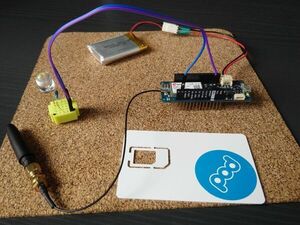
Zero Touch Provisioning based on TLS 1.3
"Device configuration from the cloud with TLS1.3 security Story The project is intended to demonstrate Pod IoT security solution – SAFE2 applet which may be used to obtain securely and in the authenticated way the configuration data from a cloud server. The SAFE2 applet is based on the expansion of the GSMA IoT SAFE idea. The applet is intended for the simplest and constrained IoT devices to provide bi-directional secure data exchange with a server. The solution is suitable to improve communication security level of already deployed projects, where the free hardware resources are not available to implement cryptographic protocols. SAFE2 The SAFE2 applet in the SIM contains an implementation of the TLS1.3 protocol in Pre Shared Key mode. The SIM not only contains the protocols logic but also stores the unique Pre Shared Key (PSK)." [...]
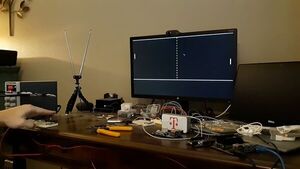
Pico Pong
"Play gesture-controlled Pong with a Raspberry Pi Pico! How It Works A Raspberry Pi Pico generates a 640x480@60Hz monochrome VGA signal. Due to memory constraints, the usable screen size is 640x350. I would like to say that I chose monochrome because it has the proper retro look for Pong, but actually I just got tired of struggling to fit a cycle-perfect VGA generator into the tiny 32-instruction deep PIO instruction memory and had no will left to squeeze in color. Data for the display is stored in a buffer in RAM, which the PIO program grabs at exactly the right nanosecond as it paints the screen via DMA. This leaves the CPU free to do other work, like play a game, while the PIO handles the cycle-intensive process of generating a VGA signal." [...]
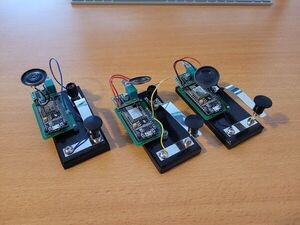
Wifi MQTT Telegraph
"Using an ESP8266 NodeMCU module connected to an MQTT service, we achieve instant intercontinental communication! (One beep at a time.) Introduction In the era of zoom calls, messenger and Snapchat, communication across the globe has become trivial. But what if it wasn't? What if one had to laboriously type out their message one beep at a time? With this WIFI telegraph project you can!" [...]
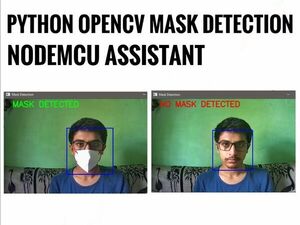
Python OpenCV NodeMCU Mask Detection
"The system prevents you to forget the mask at home and also remind you to sanitize your hands when come come Problem: so, when I go outside I forgot my mask at home then after realization, I get back home and take it it's just a waste of time Solution: made a system with OpenCV to detect I'm wearing a mask or not, if I'm not wearing a mask then it will give me a mask, and also when I return at home it reminds me to sanitize my hands How it works: the ultrasonic sensor detects that I'm in front of the camera or not. " [...]
Twister Mat MIDI Controller
"Discreetly modifying an old Twister mat to transmit MIDI note events when the circles are touched. Using 24 force-sensitive resistors, some ADCs, and an ESP-32, I've built a Bluetooth MIDI controller from an old Twister mat. The hardware is all battery powered and protected by a wooden case, so the mat can safely be placed close to falling bodies but far away from any expensive noise-making equipment. See full build video in project details, and check the Github page for source code. " [...]
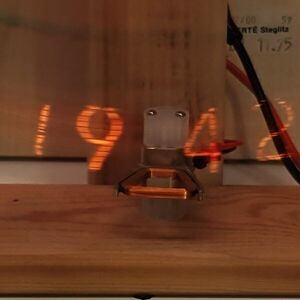
Nixie Pendulum Clock - Concept
"A pendulum clock with a NixieTube (IN-12b) that plots the time in the air it passes. It is a pendulum clock with a NixieTube (IN-12b) that plots the time in the air it passes. A magnet at the bottom of the pendulum gets pushed by an stationary air coil, as soon as it "looks" directly down. The positions of the plotted numbers are acquired by an ic accelerometer. The pendulum is ball-beard. If I would build this clock angain, i would use a ESP8266 or ESP32 smd chip so it could be flashed over the air (OTA!)" [...]
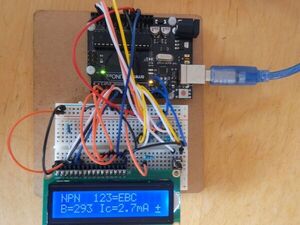
ArduTester V1.13: The Arduino UNO Transistor Tester
"Sketch of transistor tester project from Karl-Heinz Kübbeler, so it's much simpler to study, modify, verify and upload to an Arduino. This is an automatic Transistor Tester, to identify pinout and characteristics of various discrete semiconductors ( Transistors NPN, PNP, MOSFETs, etc ). It's also evaluating resistors, capacitors, inductances, etc... The original project was written in a mix of C and AVR Assembly Code for AVR gcc tooling AVR Studio. My ambition was to port it into Arduino Web Editor, so simplifying tremendously the handling of the huge configurable software, making it instantly possible to edit, verify and upload to an Arduino UNO board without the need of installing any AVR tooling Suite or using Linux OS. Most Arduino UNO Starter Kits contain the necessary components ( UNO R3 board, 1602 LCD, push buttons, Breadboard, Jumper wires, resistors )." [...]

Speed Measurement Using HC-SR04 Ultrasonic Sensor
"On this project I will show you how to measure the speed of movement of an object using HC-SR04 ultrasonic sensor. HC-SR 04 Ultrasonic sensor is most commonly used to measure distance, but this time I will show you how to measure the speed of movement of an object using this sensor. Device is very simple and consist only a few components: - Arduino Nano microcontroller - LCD display - Ultrasonic sensor - and LED diode For that purpose we need to take two distance measurements in a short time apart and we have: distance2 - distance1 = distance speed at a given time If we make the measurements in a time period of 1 second, then we get the speed of movement of the object in cm/s. The basic code is taken from the arduino cc forum and I just added an LCD display for a visual representation of the results. " [...]

ArduVMU
"DIY Arduboy with flashchip on a custom PCB + Dreamcast VMU with a busted screen = Hours of fun!!! Story With all the really cool advances and games coming out for the Arduboy system, I though it would be really cool to fit one into a VMU. I've always loved the aesthetics of the VMU and found one for $4 with a damaged LCD at a thrift store so I thought it would neat to do something with it. Features and PCB Layout To start I definitely wanted a built in Lipo battery (the original VMU chews through CR2032s and I didn't want this device to continue that legacy). So I've opted for a tiny chip I have used in the past and have a number in stock, the MAX1555. I did a little test fitting in the shell and unfortunately in order for the battery to fit I will need to cut away the coin cell battery holder plastics in the shell." [...]

ESP32 CAM WEB Server and Getting Started Guide
"Setting up the ESP32 CAM for making a Security Camera (Level 1 ) The ESP32 CAM is Basically an ESP32 without a CP2102 Chip. Instead, it is equipped with a 2MP OV2640 camera module and an SD Card Reader on the bottom side of the board. Also, the camera module is switchable, which means we can upgrade this camera from 2MP to 5MP or Higher. It cost around 10$ which is a pretty sweet price tag for such a capable Microcontroller. The WIFI module used in this Version is ESP-32S which has a built-in 32Mbit of Flash and 512KB Internal plus external 4M PSRAM. It has 9 IO Ports and its default baud rate is 115200bps." [...]

7 Segment Clock Using Arduino
"Hey guys iam back with a project which is the 7 segment clock using arduino, iam conveying my thoughts and all other things to make this hey guys here I would like to share my experiences on making this clock so you guys can also make it and can neglect the mistakes which I made while making this project. I hope you can also make this, as I do so for making this clock you need to have some soldering skill not like the pro one but a little kind of intermediatestate, I use dot-pcb for making this but you can also make it from foam board or any sort of base, and the hard part is aligning the leds and make the segments look good and promising so if you are not able to do it precisely you can make a jig or any other king of ideology like making a schematic where we need to place the leds and and sticking it to a hard surface to make this, I also made a small controller board for this project to set time. If you have read till now ur great really need an appreciation, like a sort of return it will be great if you can support me by subscribing to the channel and without further a due lets get into making. stay happy stay positive :)" [...]
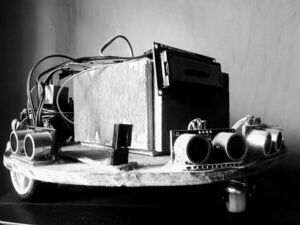
Autonomous Cleaning Robot - ACR
"In our daily life, regular scheduled tasks can be boring. With help of ACR, those task can be easy & joyful. Inspiration During the covid-19 pandemic, we have learnt the ways of doing household tasks by ourselves. Not only that, the post pandemic situation would be more valuable in need of keep maintaining those habits that grew within us. In our regular daily routine involves: Set an alarm to wake up or take medicine timely. Do Cleanup(Vacuum dirt from the floor/mop the floor)." [...]

How to Make a Mini PC for Gaming
"Story Hello, Friends. In this instructables I will show you How to Make a Gaming PC Using Lattepanda board and its Windows10 Developer board but its look like Very mini board but its powerful Operating system of this mini Computer is running windows 10 pre- installed board. I made its body from cheapest acrylic sheet, MDF wood and I have using 10 inches Display and I made this Gaming PC. I Hope you will enjoy this Instructables. In my website DiY Projects Lab having more than 25 detailed projects so you can go through this link (click here) for a more creative and amazing projects and tutorial. That will enhance your creative mind as you grow." [...]
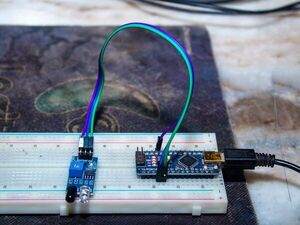
Digital Tachometer using IR Sensor
"DIY digital tachometer using IR Sensor and Arduino(No display, output shows on serial monitor). I was working with some motors and I needed to measure the RPM of it so I went online and searched for a digital tachometer but all of them were too expensive.So, I decided to make one myself using IR sensor and Arduino. " [...]
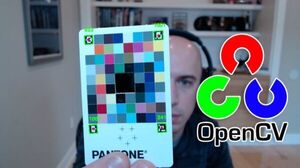
Marker-Based Augmented Reality on Ultra96-V2
"Explore augmented reality on Ultra96-V2 by adding computer generated graphics to the live USB camera video stream. Introduction Augmented Reality (AR) is a live view of a real-world environment which has been augmented with computer-generated graphics. There are two ways of implementing AR: marker-based AR marker-less AR Marker-less AR is more complex and relies on the real environment to determine references points. This usually involves recognizing objects and or background cues such as floors and walls. Marker-based AR is simpler to implement and relies on square markers located in the scene. This project will describe how to implement marker-based AR on the Ultra96-V2 using OpenCV." [...]

Micro Breadboard Power Supply
"A small Micro USB connected power supply that is designed to fit onto the power rails of a standard solderless breadboard. Inspiration While working with some of the more common breadboard power supplies that are available, I was always wanting something easier to use.It seems like these days I have significantly more Micro USB cables and USB wall adapters laying around than I do wall adapters with a barrel connector. There was also that female USB A port that I never found a good use for. I liked the way it fits into the breadboard, and the 3.3V and 5V regulators are handy. However, I wanted something a bit more practical for my circuit experiments. Seeking Something Better So what to do when faced with wanting something to exist that doesn't quite exist yet?" [...]
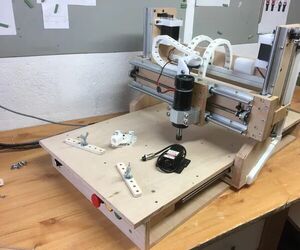
Multifunctional Hobby CNC Machine
"About 5 years ago, I made a plotter for making drawings in quite big size. It was a 2 and half axis CNC machine, because the pen had only up or down position. It turned out soon, that it is one of the painful disadvantages of the machine. The other was that I moved the whole table with the paper in the X direction, so it required large room during operation. I decided to rebuild the whole thing to have real Z axis, fix table and ability to move others than a pen. After a long planning and printing time of components I made a second version." [...]
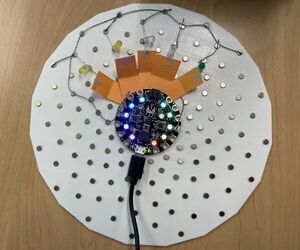
LED Keyboard Prototype
"Build a keyboard of LED lights using makeshift switches. Made in the physical computing class, ATLS 3300, at the University of Colorado, Boulder ATLAS Institute. Supplies: Adafruit Circuit Playground ThreadBoard or any preferred breadboard 5 or more LED lights Stainless steel conductive thread Paper (foldable printer paper or similar) Tape Power source (battery or USB) 4mm x 3mm magnets (optional) ThreadBoard as described here5 or more LED lightsStainless steel conductive thread4mm x 3mm magnets as neededPower source (battery or USB)" [...]

Useless Box
"Interested in making a useless box? Building this project was a really fun experience for me. Having very little prior knowledge about circuits, making this simple gadget was a great introduction to circuits for me. And, it's really fun to play with once completed! This project is meant for beginners with little or no experience making circuits, and using an Arduino. I built this project for my Principles of Engineering class taught by Ms. Berbawy." [...]

DIY Solar Panel Monitoring System - V1.0
"A few months back, I have installed a small-scale Off-Grid Solar System. I am always very curious to see the performance of my solar PV system, and the good news is that the charge controller that I am using has its own local display for monitoring. But, I am badly missing the remote monitoring facility. So, I have decided to make my own monitoring system which must have both local and remote monitoring facilities. Why We Need Monitoring? 1." [...]
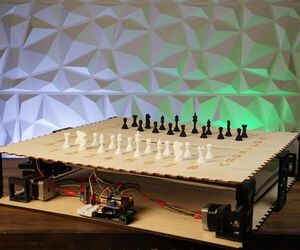
Wizard Chess
"Wizard Chess is a form of chess originally invented by J.K. Rowling in Harry Potter and the Sorcerer's Stone. The characters give verbal commands to the chess pieces and they move by magic. Seems impossible right? Not anymore! Using an Arduino Uno, along with an XY plotter, Wizard Chess can be recreated in real life! You can now play a full game of chess using voice commands and the chess pieces will automatically react accordingly." [...]
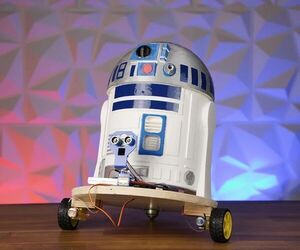
3D Printed Obstacle Avoiding R2D2 Using an Arduino Uno in 13 Steps
"Every Star Wars fan in existence would love to live in a galaxy far, far away. They could wield a lightsaber, fly the Millennium Falcon, or in this case, take a walk in the park with R2D2. This Instructable will give detailed instructions on how to make your very own obstacle avoiding R2D2. I decided to build an Obstacle Avoiding R2D2 for my Principles of Engineering SIDE Project because it seemed like a good challenge for my CAD skills. Guidance and materials were provided by my Principles of Engineering teacher Ms. Berbawy. The electronics section of R2D2 was given by user Nayantha KGD's very own Obstacle Avoiding Robot Instructable." [...]

Circuit Playground Extension - E-Textile Debugging Tool
"The Circuit Playground Extension is a tool that enables the user to design e-textile circuitry with debugging in mind. To use the tool, the user would sew the extension into their project with the holes in the extension's substrate matching with the pins that the user wants to connect to on the Circuit Playground. The user would then attach stainless steel thread to the magnet in Circuit Playground pins and to the corresponding hole in the extension. If the project is not working as expected the user can: 1. Remove thread connections to the pins, this will separate power from a particular part of the circuit so that the user can test functionality one at a time (isolation switches). 2." [...]
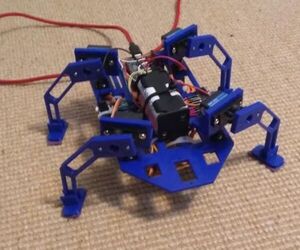
Tom the Tortoise Thief
"I had 8 small and really old servos, as well as an ESP32 that was soldered onto a copper stripboard. I therefore decided to make a walking quadruped that would have something sticky on it's stomach, allowing it to pick things up secretly when it belly flopped, (Like a card). Because I only had 8 servos I could not use the normal 3 servos per leg that quadrupeds and hexapods use, I would be stuck using only 2 per leg. This combined with quadrupeds having a much harder time balancing than hexapods due to the gait, meant that it was destined to be slow from the start. (On the flipside, no-one ever expects a tortoise to run off with their credit card, so it always gets away). In addition, most ESP32s have wifi, so we can control the bot from a PC." [...]
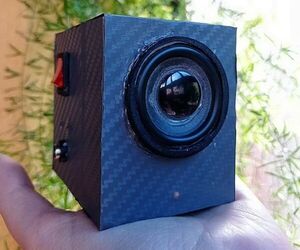
DIY Bluetooth Speaker
"Hello everybody In this instructable I m gonna show you how to make a simple good-looking (and good sounding) Bluetooth speaker. I made a few speakers in the past but in this one, I made my own speaker box as well (I didn't use an existing box to put an amplifier and speaker in). And since this is a Sticky Stuff Speed Challenge I used glue to put the box together so no screws were used in this project. This project isn't all that hard so you don't need some mad woodworking and electronic skills to make this, but I would recommend you a lot of patience. As I mentioned before that no screws were used in this project which means that the whole box is held together by glue. So for best results leave epoxy to set properly." [...]

ESP32 Multicolor Word Clock
"The Multicolor Word Clock is a Variant of the Wordclocks which takes Advabtage of WS2812 Multicolor LEDs (aka NeoPixel) and the Power of an ESP32. Whilst other Word Clocks have the Problem that there aren't enough GPIOs for the Words, the WS2812 only need one GPIO as the Color and so the ON/OFF Info get's handed from one LED to another by the DataIN/ DOUT Pins on each LED.Logically there is only one long Ribbon of LEDs instead of single Words. To be able to take full advantage of these LEDs I took an ESP32 with a Webserver to be able to switch color modes without having to flash again. Surely the Hardware can be altered (I was too lazy to cut out the Letters) but I do like the solution with the printed Paper. This is my first instructable so be kind ;) The Code is based on Work of Rui Santos from Randomnerdtutorials.com, the greatest site to learn ESP32. Supplies: For the Clock itself I took: A Bunch of 100 WS2812 LEDs which come as one element by 10x10 LEDs." [...]

A Shuttle Mission Control Mock-Up for Kids
"A Mission Control Center for children was constructed to manage a pretend launch of the space shuttle. I wanted to play-out the make believe mission with nothing but LED lamps to tell the story; both 7-segment displays and graphic displays with LED lights strategically mounted. I tried to keep it straight forward and sequential with required child interaction so they felt they were really directing a space shuttle mission. The Mission Control Center is in a self-contained wooden box that is painted a silver/gray color to look like metal. This makes it easy to transport. The control center is made up of smaller panels that have specific functions or show specific information concerning the make believe shuttle launch." [...]
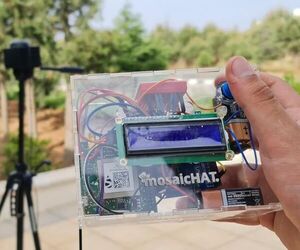
Building a GPS/GNSS Receiver Using MosaicHAT and Arduino
"Throughout the following steps, we'll see how to build a GPS/GNSS receiver using Arduino and mosaicHAT. mosaicHAT is a Raspberry Pi compatible GNSS board based on Septentrio module, mosaic-X5, the centimeter-level multi-band, multi-constellation GPS/GNSS receiver. The compact mosaicHAT make it incredibly handy to provide IoT and robotics applications with highly accurate and precise positioning. mosaicHAT project is open-source, fully documented on Github and can be easily manufactured or integrated into different designs: https://github.com/septentrio-gnss/mosaicHAT To build this project, we need the following components: Arduino UNO (or any Arduino type actually) mosaicHAT GNSS antenna 16*2 LCD screen (12C) Breadboard 2* 9V batteries 2* battery connector Pushbutton Wires" [...]

Mini Light Cube
"For this instructable, I will cover how to create this wood and acrylic mini light cube without using any power tools. I was initially inspired by RepRevMakes LED lamp on YouTube, however I did not have access to a circular saw so could not build it. I decided to re-engineer a version so it could be built without any power tools using only pre-cut parts ordered online. This creates a cube approximately 6.6 cm which is about the size of a Rubix cube, though you could scale this design up. In addition to the steps in this guide, I have created this short animated version on You Tube that covers the full build process and parts. Supplies: The cube is made from pre-cut parts that are glued together." [...]
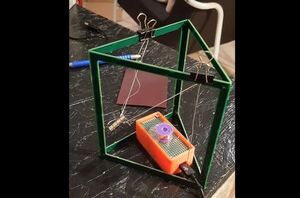
Yet Another Perpetual Pendulum
"Heya. So I found people building perpetual self-exciting pendulums (pendula? pendulae?) and showing them off on youtube. Nice 🙂 So far the most elegant that I know of seems to be THIS ONE by youtube channel [TinselKoala] … which is in turn a “cover version” of some original circuit by David Williams, published in the magazine(?) “Nuts & Volts” in August 2012." [...]

DIY Arduino based resistor reel cutting machine
"Hello guys in this video I have made a Arduino based resistor reel cutting machine this machine can cut reels in small quantities. how many resistor you need to cut in single set you can provide the input to the HMI and machine do it for you. two vertical blades are connected with stepper motor and resistor is feed horizontally via roller arrangement with is powered with stepper motor. Material used Nema 17 Stepper motor 3 nos. Multipurpose PCB A4988 stepper driver 2 nos L2988N motor driver Arduino nano Circuit drawing I have used my multipurpose PCB for Arduino based resistor reel cutting machine project. " [...]
Secção Videos
Videos interessantes.
That's all Folks!




